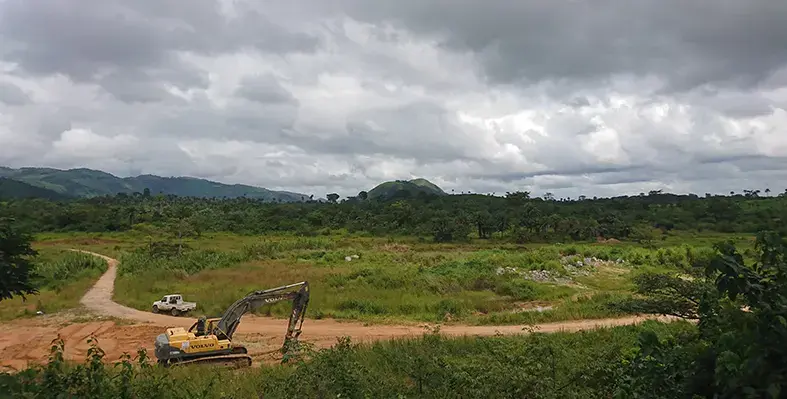Developments in the Democratic Republic of Congo show that the country’s mining sector is transitioning from volume-driven extraction to a more structured industry focused on global standards and sustainability
Reflecting on the recent 20th DRC Mining Week in Lubumbashi, SRK Consulting (Congo) chairman and geological consultant Dominique Sambwa said the event highlighted a range of positive signs that are underpinning the country’s future prospects as a mining giant. These included infrastructure for energy security, adoption of mining industry standards, and a peace agreement that could facilitate better access to mineral deposits.
“With the number of attendees reaching about 5,000 this year, the event was a significant forum for all stakeholders including government, who provided encouraging updates on progress in power and transport infrastructure projects,” said Sambwa. “These developments are essential in allowing mining companies to scale their operations, as well as for exploration efforts to access new areas – so that the DRC’s mining sector can continue to diversify beyond copper and cobalt.”
Lobito rail link
Among the key infrastructure projects underway was the Lobito Corridor – a rail link connecting the DRC’s mineral-rich regions with the Angolan port of Lobito – which is supported by the International Finance Corporation.
He highlighted the growing interest in lithium deposits such as Manono in DRC’s eastern region, and diamond prospects in central DRC. Investor interest is certainly increasing, he noted, with significant representation at the event from Western countries like the US.
“Everyone active and interested in the DRC has also been heartened by the moves to secure a peace deal between the DRC and Rwanda, as this could catalyse further investment and mining expansion – especially in areas that have been destabilised by military activity,” remarked Sambwa.
Clean power
The World Bank-funded phase 1 of Inga 3 hydroelectric scheme was another topical project discussed at DRC Mining Week that holds great promise for the future of mining, said Nicolaas Steenkamp, principal consultant at SRK Consulting (South Africa).
“Clean hydropower through a large scheme like this will facilitate considerable expansion of mining operations, by strengthening the availability and reliability of power through the main grid,” said Steenkamp. “Where it could replace costly diesel-generated power on mines, such an energy source could also make production costs more globally competitive, while helping mines to decarbonise as part of industry-wide sustainability efforts.”
He noted that the DRC’s cleaner sources of grid energy could also position the country’s producers as leaders in the move toward a preference for ‘green copper’ among customers pursuing the energy transition away from fossil fuels. The 240MW Busanga hydroelectric plant north of Kolwezi on the Lualuba River is among the most recent renewable projects to be commissioned. There are also a number of solar power developments underway on mines, aiming to harness renewable sources while stabilising on-site power supply and driving the green agenda.
Socio-economic impact
The mining industry’s recent trajectory in the DRC has been marked by local regulations to harness its positive impact on the economy and broader society, as well as by a growing acceptance of global standards – especially those related to environmental, social and governance (ESG) concerns. The evolving regulatory framework hopes to nurture local suppliers and professional service providers to the industry, as well as improve relationships between mines and communities through more systematic engagement, said Sambwa.
“Subcontracting firms in mining must now be at least 51% owned by Congolese shareholders, and there are local procurement requirements for mining and service contracts,” he said. “Mining companies are also mandated to prioritise the employment of locals – to promote the integration of the domestic economy.”
Standards show the way
With international focus on the integrity and ethics of the mining supply chain, and led by major global players already active in the DRC, miners in the country are increasingly embracing industry standards, according to SRK Consulting (South Africa) partner and principal environmental scientist Wouter Jordaan.
“As a strategy to meet international best practice and mitigate risk – while also aligning with the requirements of the larger financial institutions and stock exchanges – we are seeing a definite trend in the DRC towards compliance with one or more standards,” said Jordaan. “Mining companies are recognising that they are part of a value chain is becoming more demanding.”He added that standards like The Copper Mark and the Initiative for Responsible Mining Assurance (IRMA) are not only well-recognised by others in the supply chain, but they provide mines with a clear and structured path to compliance. Other industry benchmarks are also coming into focus for players in the DRC, commented Malcolm Maber, partner and principal geotechnical engineer at SRK Consulting (SA).
“As exhibitors at DRC Mining Week, we engaged with many visitors about the requirements of the Global Industry Standard on Tailings Management (GISTM), especially the ESG elements,” said Maber. “It is clear that companies operating in the country are keen to start understanding and implementing this standard – if they haven’t already started.”
Looking ahead
Sambwa said the DRC Mining Week emphasised the potentially positive impacts of government efforts to date in trying to optimise the benefits that nearby communities gain from mining operations. This included the social investment of 0,3% of mines’ turnover to community funds, to support upliftment and local economic development.
“Of course, the social benefit is unevenly spread across the country, as it only applies in the mining regions,” he said. “However, the impact can be positive if the arrangement is well managed by skilled professionals, and if there is a high level of transparency in matters such as revenues and contributions.”





